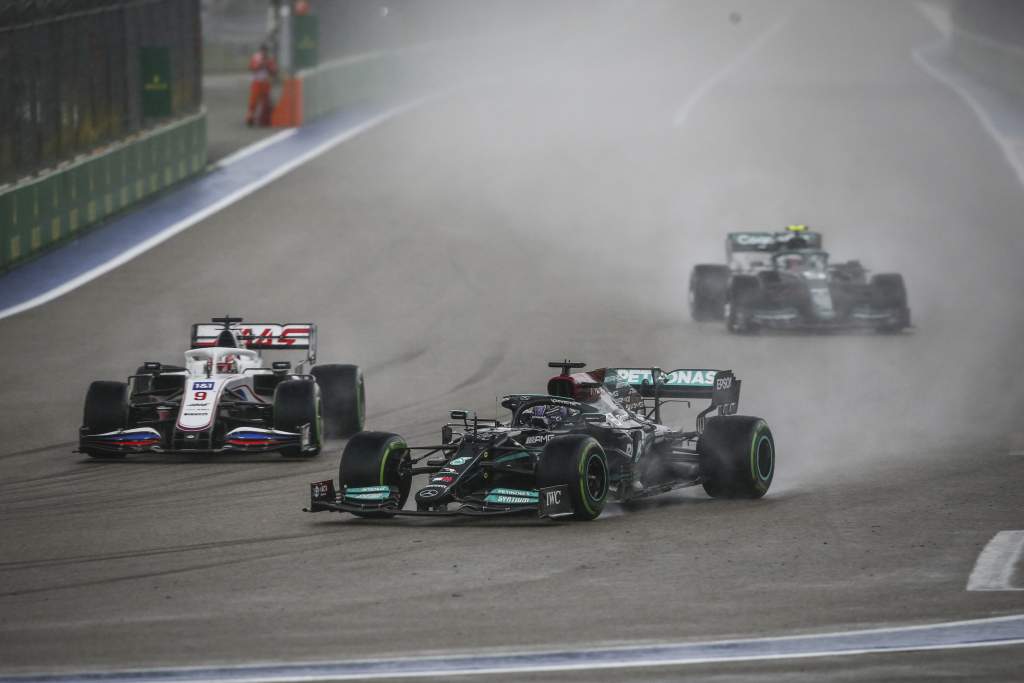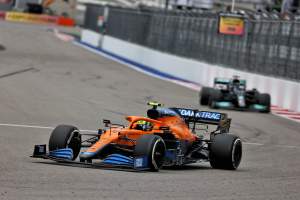Up Next

The Sochi rain played its games and on both Saturday and Sunday dealt the Formula 1 teams impossible hands.
It was really not a matter of merit whether you made the right call at the end of qualifying to stay on intermediates or switch to slicks. Just as it wasn’t in the closing stages of the race when it was all about whether to stay on slicks or make a late move to inters.
You guessed right or you guessed wrong. The level of risk you were prepared to take determined the call you were likely to make.
So Lando Norris/McLaren made the right call on Saturday and Lewis Hamilton/Mercedes the wrong one. In the inverted weather situation of Sunday, it was Hamilton/Mercedes who made the right call, Norris/McLaren the wrong one.
But behind Hamilton’s dramatic 100th grand prix victory and the heartbreak of Norris – who’d driven quite brilliantly all weekend and looked poised for his maiden grand prix victory until five laps from the end and ended up only seventh – there were all sorts of knife edge decisions being forced upon them.
Hamilton in fact had ignored the call to come in on the 48th lap (with five laps to go). Norris did the same. Had Lando instead come in at that point, he’d have likely retained the lead and won and Hamilton’s refusal would have cost him any chance of victory.
Instead, Hamilton came in next lap and still Norris stayed out, arguing against his team for what he felt was going to give him victory. It was of no consolation to him that Hamilton had assessed the situation just the same as him but been overruled.
At Red Bull meanwhile, Max Verstappen made his own call to pit on the lap Mercedes was first calling Hamilton in – and in so doing vaulted from sixth to a remarkable second from the back of the grid.
That was just the finishing flourish to several distinct phases of this dramatic race.
First phase: Hamilton trapped
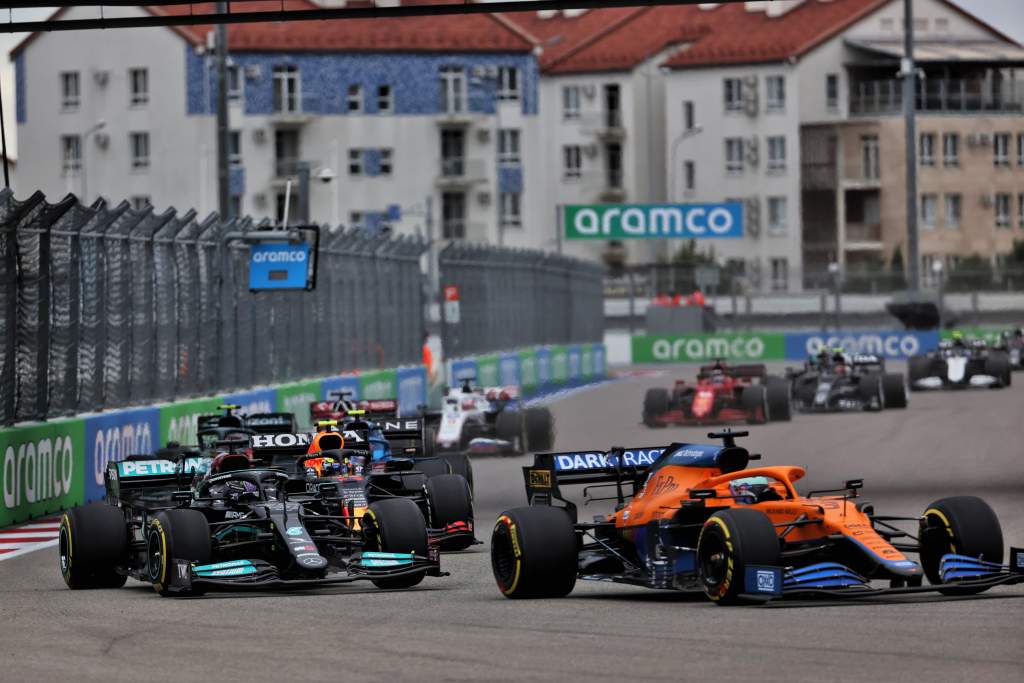
The dynamics of the race were determined not only by the unusual Norris/Carlos Sainz/George Russell/Hamilton grid, but also by the way things panned out into Turn 2 at the start of the race.
There was a lot of support race rubber down on Sainz’s side of the grid and hardly any at all on the pole side for some reason. So Norris’s start was OK, but Sainz’s was terrific, enabling him to get straight into Norris’s slipstream and to hold Russell’s Williams out on its own, having to push its own air aside.
Hamilton also got a great getaway from that rubbered-in side and was catching Norris/Sainz and looking set to go down their inside.
Before that could happen, Norris moved right to block the Mercedes, allowing Sainz to flick the Ferrari left and slipstream himself into the lead. Norris backing off early boxed Hamilton in, enabling Russell and Lance Stroll to pass him on the outside approach to Turn 2.
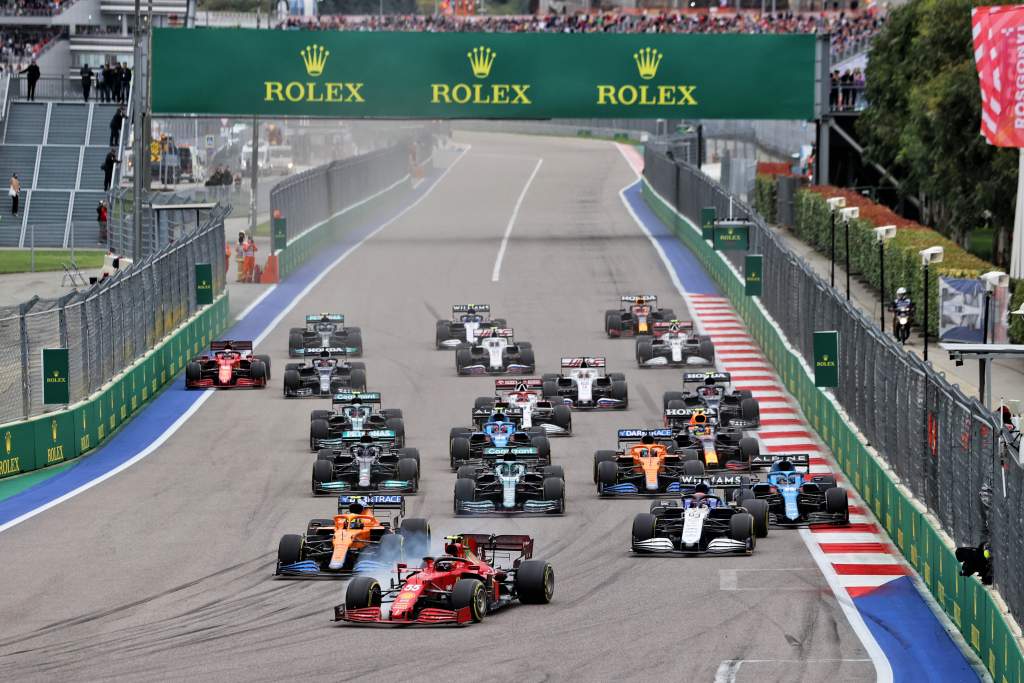
Making it yet-worse, it allowed Daniel Ricciardo to get a run on him on the exit and to outbrake him into Turn 4 and Fernando Alonso – who’d not tried too hard not to use the Turn 2 run-off he’d trialled on the formation lap – got ahead too. From ‘should have been pole’, to fourth on the grid to seventh at the end of the lap, things weren’t going well for Hamilton.
He’d repass Alonso easily enough on the second lap but of all the things to be stuck behind, Ricciardo’s McLaren was the worst – as he well knew from Monza.
Ricciardo was running with less wing than Norris and was very quick on the straight. Hamilton had switched to the maximum wing setting that Bottas had used since Friday and although it was still quick on the straight it wasn’t quick enough to find a way by Ricciardo.
Hamilton was trapped there, with Sergio Perez – who’d passed Alonso – on his hard tyres right behind. The top five had all begun on the medium, but the hard was the better tyre after about four laps. Alonso, Perez, Pierre Gasly, Bottas, Verstappen and Charles Leclerc (starting from the back with his new-spec Ferrari power unit) had all chosen it.
With Russell’s over-qualified Williams in third holding up a big queue of cars, it was the dream scenario for Sainz and Norris who quickly pulled out a good gap on the field. And a nightmare for Hamilton who was stuck in the DRS train behind Ricciardo at a Williams-dictated pace.
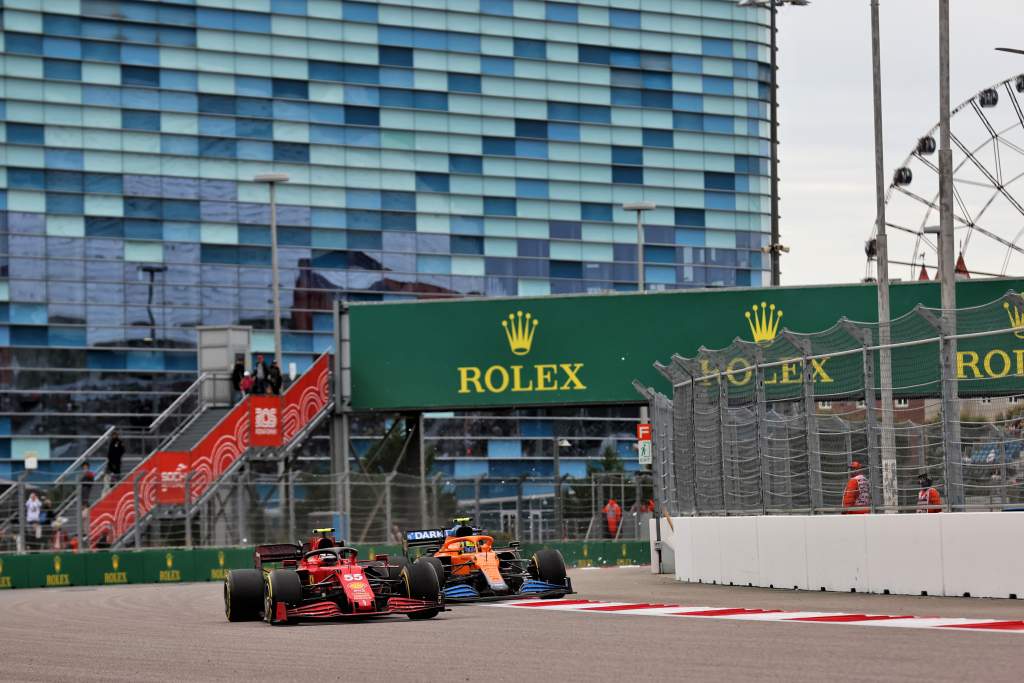
Sainz, having stepped up the pace on the fourth lap to pull out an impressive-looking gap over Norris, began to destroy his left-front and within three more laps Norris was coming back at him, having run a pace kinder to that vulnerable left-front medium.
Normally Sochi is a rear-limited track but in these cool conditions the front-left of the medium compound became very susceptible to graining. Mercedes and McLaren had taken the precaution of adding some front flap to help protect it. This Ferrari is often on the cusp of mistreating its fronts anyway and the cool conditions here seemed to bring that out.
By the ninth lap Norris was within DRS reach of the Ferrari and a couple of laps later was all over it through Turn 2/3. Both were now saying their left-fronts were dying but the Ferrari was clearly more seriously afflicted and on the 13th lap Norris slipstreamed/DRS’d him down the back straight and put a brave move around the outside approach of Turn 13 to take the lead. “Got him,” he radioed matter-of-factly.
They were now over 7s clear of the Russell train behind, but the Williams was in at the end of the lap, responding to an undercut challenge from Stroll.
Sainz would stop the next lap to be rid of the graining mediums. His set of hards would have to last 39 laps, not the ideal stint length but perfectly doable.
McLaren chose not to respond and Lando kept pumping out the laps, finding that actually once in clear air, he could get past the graining phase. He was good for many more laps yet.
At no stage did Bottas look like he was much interested in this race
With Russell and Stroll out of the way and Sainz pitting too, McLaren was running 1-2 and Ricciardo might have been expected to have picked up the pace. But he didn’t really. A little, but Norris continued to pull out time on him. This was looking rather like Ricciardo’s job was to hold Hamilton off for as long as possible, thereby delaying when he might arrive on Norris’ tail.
Verstappen meanwhile, from the back of the grid (for the fresh Honda power unit and associated components), on his hard-tyred opening stint with his trimmed-out rear wing was picking off the slower cars easily enough. So, with Hamilton trapped in Russell’s DRS train, Verstappen was soon enough making time on him.
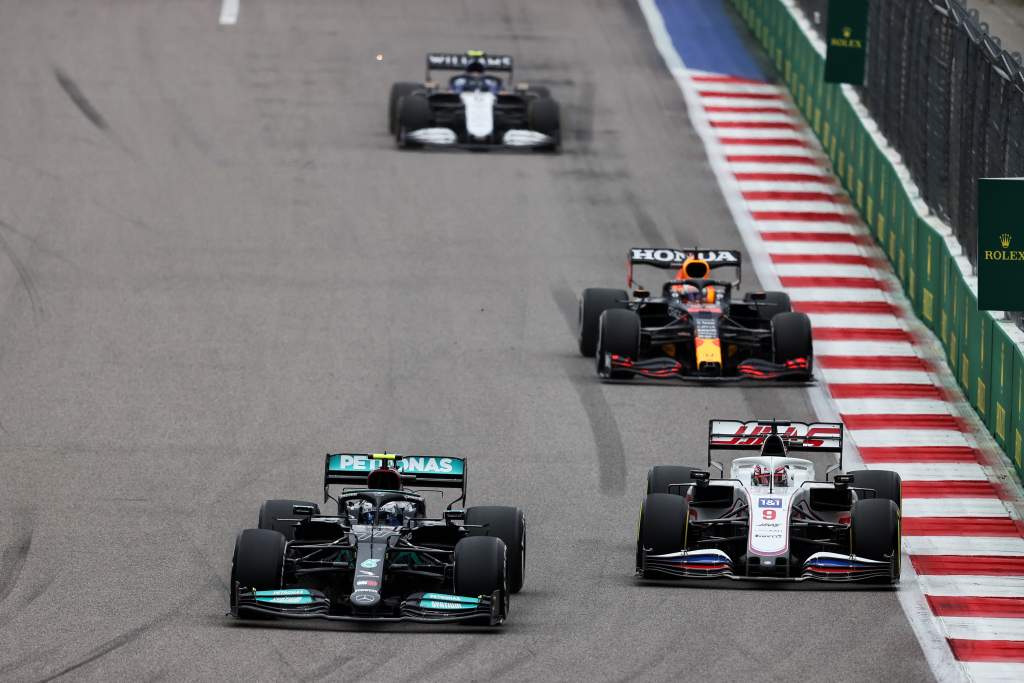
Mercedes would therefore have been disappointed that Valtteri Bottas – who started with what was officially a 15-place grid drop in 16th for a new power unit, which was very much for a technical reason and not simply tactical, as there was a problem with the unit introduced at Monza – offered no resistance when Verstappen calmly outbraked him into Turn 4 on the sixth lap. “I didn’t know he was there,” claimed Valtteri later.
But at no stage did Bottas look like he was much interested in this race. Even an irritated-sounding gee-up from Toto Wolff a few laps later had no apparent effect.
Verstappen was long-gone and would continue picking off cars as Bottas was mired in position. By lap 10 Verstappen was six places and 9s behind Hamilton. Three laps later it was five places and 7s. As others pitted out of Verstappen’s way, it was three places.
Then in clear air for the first time he really let rip and was fastest car on track, up to 1.5s faster than Hamilton. By the 22nd lap it was reaching crisis time for Mercedes as not only was Verstappen just 3s behind, but it was getting late enough that Perez – who would be obliged to switch to mediums, with a range of around 25-30 laps – could undercut Hamilton.
“Do the opposite of Ricciardo,” Hamilton was told on the 22nd lap. To Hamilton’s relief McLaren pitted Ricciardo at the end of that lap (Daniel suffering a slow change on the front-left).
In clear air for the first time, here’s when we’d get to see Hamilton’s actual pace and whether it might be enough to close down the 8s Norris had over him and halt Verstappen’s inroads from behind.
Second phase: Norris vs Hamilton
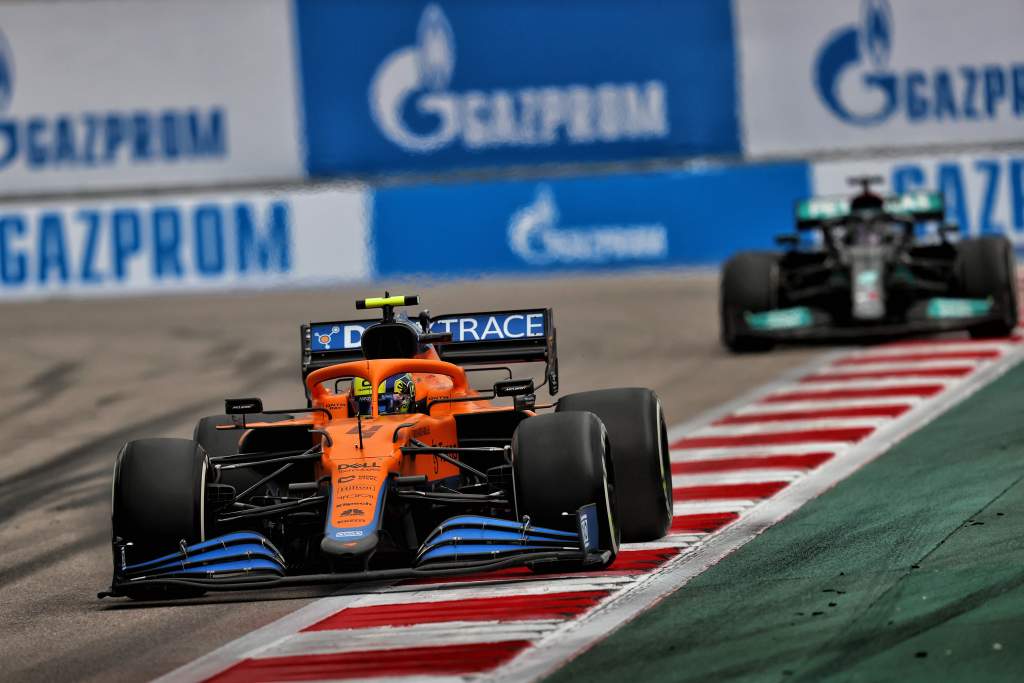
Hamilton needed to get himself out of undercut reach of those Red Bulls. He’d been smart enough not to sit in Ricciardo’s slipstream once it was clear there was no way by, so he still had tyre life left in his mediums – at just the point that Verstappen’s hards were beginning to wilt. That was the penalty of Max’s much busier race from the back of the grid.
Over the next four laps Hamilton increased his gap over Verstappen by 3s and as soon as there was a nice gap to drop into he was brought in.
Red Bull brought Verstappen in on the same lap. They rejoined still separated by three places.
Verstappen’s mediums would only be quicker than Hamilton’s hards for a few laps. Thereafter Hamilton would be on the faster tyre. He was no longer in danger from the Red Bulls. His target now was Norris – and that 100th victory.
McLaren responded with Norris the next lap and he rejoined 8s ahead of Hamilton, with the yet-to-stop Gasly and the earlier stopping Sainz between them. Hamilton put moves on those two briskly enough.
By lap 30 Norris and Hamilton were fourth and fifth separated by 8s and behind only the yet-to-stop hard-tyred cars of Perez, Alonso and Leclerc.
Complicating matters for Norris, he had to save fuel to bring himself back on schedule. He knew Hamilton was coming, so no point pushing any harder than necessary. That way, saving fuel, he could look after his tyres too – so giving himself half a chance of having enough grip to hold off Hamilton once the Mercedes arrived on his tail.
And so the gap came steadily down as the laps ticked away. Would Hamilton run out of time? Would he have the tyre grip when he got there? Would Norris’s McLaren be any easier to pass than Ricciardo’s had been?

Was Norris about to take that first victory the day after taking his first pole? Or was Hamilton about to pull a dazzling victory out of adversity, like he so often has?
After the hard-tyred runners had pitted and Perez had suffered a 5s delay on the left-rear, the order a long way behind Norris and Hamilton was a tight little group comprising Sainz, Ricciardo, Perez, Verstappen and Alonso.
Verstappen had killed the left-front medium quite quickly and was overtaken by Alonso, who was in vintage fast and attacking form. Perez had the grip to pass Ricciardo at Turn 13 and a couple of laps later the very old-tyred Sainz for third, thus putting himself back where he’d have been without the pitstop delay.
Every time Hamilton tried to get closer to Norris, the understeer forced him back, as if there was a forcefield around the McLaren
Some way behind them were Stroll and Russell, the Williams having sunk back to its natural level, fending off Esteban Ocon’s Alpine, Kimi Raikkonen’s Alfa Romeo and Sebastian Vettel’s Aston Martin, with the recovering Leclerc set to catch and pass that group of four slower cars. Bottas was a lowly 14th and looking set to stay there.
That’s how it was all looking before the rain came with five laps to go. Hamilton had got to within 1.1s of Norris, but struggled to get any closer. Every time he tried, the understeer forced him back, as if there was a forcefield around the McLaren. He later admitted he didn’t believe he was going to be able to do anything about it.
Perez looked set for third, Alonso may have had a run at Sainz. Verstappen was struggling with that grained-up front-left and probably wouldn’t have bettered sixth, with Leclerc probably applying some late pressure.
Third Phase: Rain the Randomiser
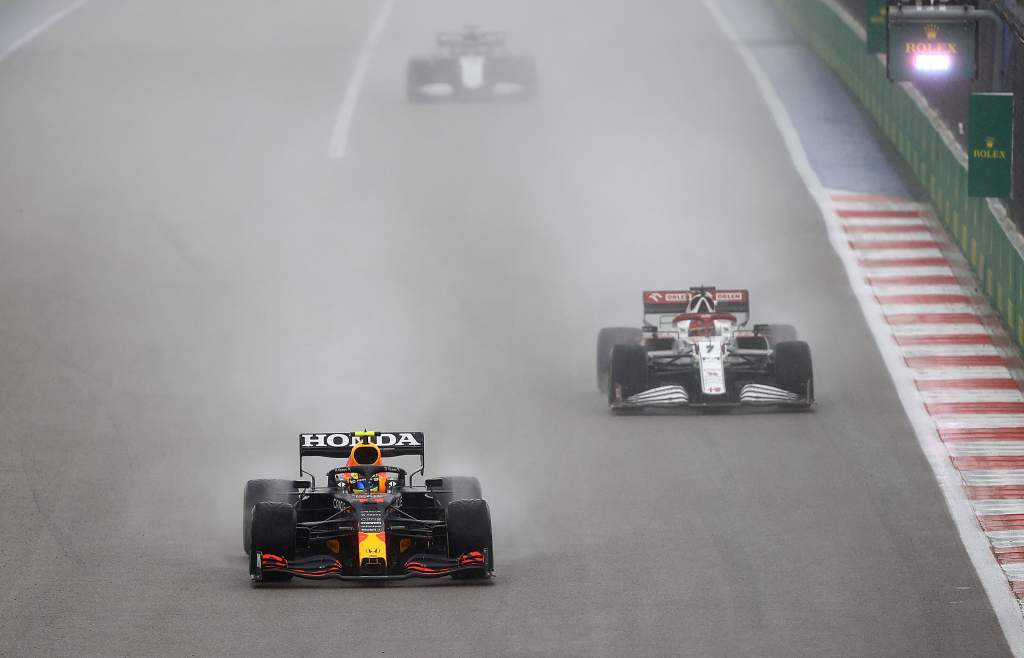
Five laps to go, it came in two waves, the second just 30s behind the first. That was its special trick. Jeopardy and opportunity and an agonising choice for Norris and McLaren.
Cars began sliding onto the run-off, particularly at Turns 6 and 7. Mercedes had the luxury of Bottas being well out of the points so could bring him in early as a guide. That was lap 47.
Not only did Bottas’s out-lap sector times confirm the inters were much quicker – and were thereby set to rescue Bottas’s day from oblivion – but the second rain front became more clearly defined on the radar at just the same time. Norris and Hamilton were both called in but just as the first front was passing. It seemed to them the track was drying out.
Both ignored the request. At Mercedes it was explained to Hamilton that more rain was on the way. He pressed his pit confirm button and the request thereby didn’t need to become a team order.
Norris was being told the rain would remain constant and so he based his adamant refusal to come in on that. He took to the run-off several times, but then so did Hamilton who was unable to take advantage.
Verstappen had already made his own call – and came in on lap 48, keen to be rid of his damaged slicks anyway. That early call would boost him several places. Sainz had made the same decision at the same time, as would Ricciardo.
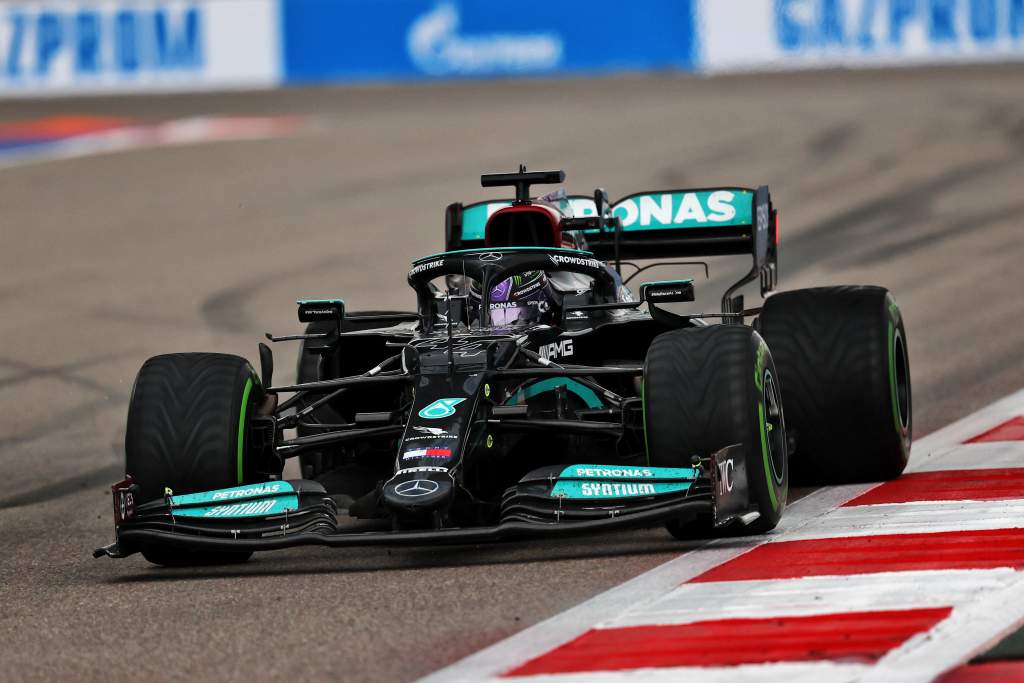
Hamilton pitted a lap later than those guys but had been so far ahead he was under no threat from them. Norris stayed out but by the 51st lap that second front had arrived with a vengeance and it was much heavier than the first.
Norris was helpless on his slicks and into Turn 5 he spun to a brief halt on the run-off just as Hamilton on his inters was set to pass anyway.
Norris got going again to make his way gingerly to the pits for the inters that needed to have gone on three laps ago. Pole position and fastest race lap to add to his eighth place finish was such poor reward for a fantastic performance.
Verstappen’s early call jumped him up to second, albeit a very long way behind Hamilton. Sainz’s similar early call got him third, though on his ancient hard tyres he was passed on his in-lap by Verstappen. Ricciardo’s early stop got him fourth.
Leclerc had been right with Sainz and Verstappen on their in-laps but opted to continue rather than be stacked behind Sainz. Indecision in the tricky conditions between him and his engineer led him to make a disastrous decision not to at least come in on the next lap and instead try to brave it out. Which dropped him to oblivion.
Bottas, the earliest of all the stoppers, jumped from 14th to fifth and Raikkonen’s decisive early call jumped him up to eighth, passed right at the end by the dejected Norris.
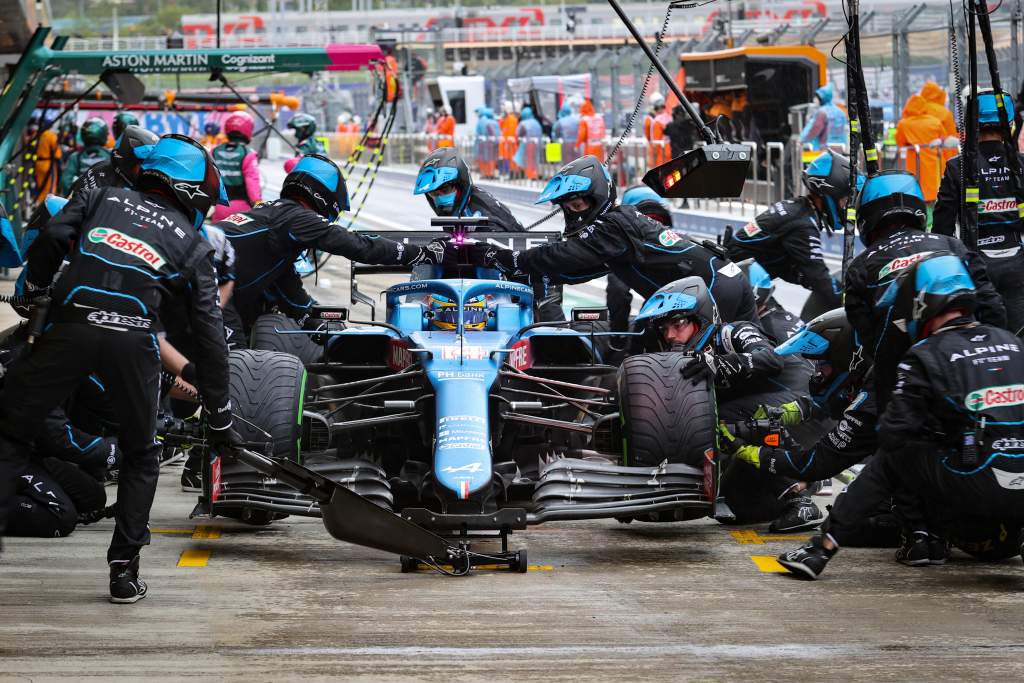
Alonso left it a couple of laps too late for his stop otherwise he could have been third rather than sixth while the similarly late-stopping Perez, whom Alonso passed in the slithery slicks-on-wet track laps, fell from a likely podium to ninth.
Russell got in plenty early but had only used inters left and so struggled across the line for the final point, but he’d made a bigger one – again – in qualifying.
How many of Hamilton’s 100 victories have been as dramatic as this one? It’s pointless to ask the man himself as it’s way too big a number to choose from over so long a time period.
“I could only ever have dreamed of still being here and having this opportunity to win these races and get to drive against such phenomenal talent this late in my career,” he said graciously. He has a point there, but not one which can be added to the two by which he now leads Verstappen in the championship.

